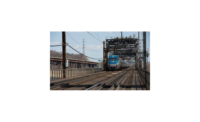Forty transportation projects across a variety of modes have won grants totaling $484 million in the latest round of the U.S. Dept. of Transportation’s Transportation Investment Generating Economic Recovery (TIGER) program.
As with the previous TIGER rounds, the new group of winners, announced on July 28, emerged after an intense competition. DOT reported that, this year, it received 585 applications seeking more than $9.3 billion.
DOT Secretary Anthony Foxx told reporters in a conference call that highway and bridge projects accounted for 2016 TIGER funds' largest share: $193 million.
Pedestrian and bicycle paths received $97 million, followed by $93 million for transit projects, $54 million for maritime infrastructure, and $47 million for passenger and freight rail.
The Chicago Transit Authority won the largest single grant, $25 million, to help finance a $50.4-million upgrade to the Garfield Station on the El's Green Line.
Three other projects each received a $20-million TIGER grant: a New Haven, Conn., proposal to convert a limited-access highway to an “urban boulevard”; roadway, sidewalk and other improvements in Flint, Mich.; and Utah Transit Authority’s plan to improve access to its transit system.
Foxx also noted that nearly two-thirds of this year’s winners were unsuccessful applicants in earlier rounds. For example, Pittsburgh lost out in two past TIGER competitions, but it won $19 million in the latest round, the eighth since the program was established in 2009.
The new federal funds will help to finance a $32-million plan that includes a new “cap connector” over a below-grade, crosstown highway. The cap, plus improved crosswalks and walkways and a new “greenway,” will create a link to downtown for the city’s Hill District, a neighborhood that was cut off by the construction of the highway in the 1950s, according to the TIGER application from the Sports & Exhibition Authority of Pittsburgh and Allegheny County.
The project is an example of one of Foxx’s priorities, using infrastructure projects as “ladders of opportunity”—links to jobs, retail and other needs for urban neighborhoods isolated by the construction of Interstates and other highways.
Pittsburgh Mayor Bill Peduto (D) said in the conference call that the city’s first unsuccessful proposal involved reestablishing a network of streets in the Hill District. When U.S. DOT provided feedback after that round, it emphasized, “You need to really connect this neighborhood back with the [downtown] employment center,” Peduto noted.
Pittsburgh sponsors reapplied, this time concentrating on building a way to cross the highway. However, that second effort also didn’t win.
Foxx said Pittsburgh's 2016 proposal focused on the highway cap concept, apparently refined from the previous version. Peduto said its landscaped surface will be a park that stretches as a greenway into the Hill District neighborhood.
Despite TIGER’s strong popularity among federal lawmakers from both parties, its survival past this year isn’t guaranteed.
The program lacks a multiyear authorization—something the Obama administration had proposed—and, instead, has relied on year-by-year congressional appropriations.
Foxx said, “My hope and expectation is that [TIGER] will continue, but that is subject to the appropriations process, currently.”



Post a comment to this article
Report Abusive Comment